Guitar modes. The very phrase can send shivers down the spine of even seasoned guitar players. It’s a topic often shrouded in mystery, causing confusion and frustration for those seeking to expand their musical horizons beyond basic scales. I can certainly relate to this from my own early experiences.
When I first ventured beyond the familiar territories of the minor and major pentatonic, and the blues scales, the world of modes seemed like an impenetrable fortress. Self-teaching proved largely unsuccessful, and in retrospect, it’s easy to see why.
The language surrounding guitar modes is often complex and theoretical. Truly understanding and effectively utilizing modes requires a foundational grasp of music theory. While you can achieve impressive results improvising with the minor pentatonic scale even with limited theoretical knowledge, the same cannot be said for modes. If you’re new to music theory, I strongly advise reviewing these articles before diving deeper into modes:
I understand the eagerness to master guitar modes quickly. But trust me, learning from my past struggles will save you time and frustration. Attempting to tackle modes without understanding their underlying principles is incredibly challenging and leads to inconsistent results.
Investing time in building a solid theoretical foundation is invaluable. It will empower you to use guitar modes with greater precision and effectiveness. In fact, I believe this approach will ultimately be more efficient in the long run.
Assuming you’re comfortable with the concepts in the linked articles, let’s turn our attention to guitar modes. This guide covers everything you need to start using modes on your guitar, including:
So, let’s embark on this journey to understand and play guitar modes! Here’s an introduction to unlocking the modal world on your guitar:
The Foundation: The Major Scale
Before exploring guitar modes, we must revisit the major scale. It’s the cornerstone, the ‘parent scale’ from which all modes are derived. Understanding the major scale is paramount to understanding modes.
To effectively play guitar modes, you must first be proficient in playing the major scale across the fretboard. Furthermore, you need to comprehend its structure and the intervals it contains.
Let’s quickly recap the essentials:
The major scale is a heptatonic scale, meaning it comprises 7 notes per octave (from the Greek ‘hepta’ for 7). Its formula is:
1 2 3 4 5 6 7
Each number represents an interval within the scale. In the major scale, all intervals are either major or perfect. In A major, the notes are:
A B C♯ D E F♯ G♯
Number 1 corresponds to A, 2 to B, and so on. Here’s the A major scale played horizontally on the 6th string:
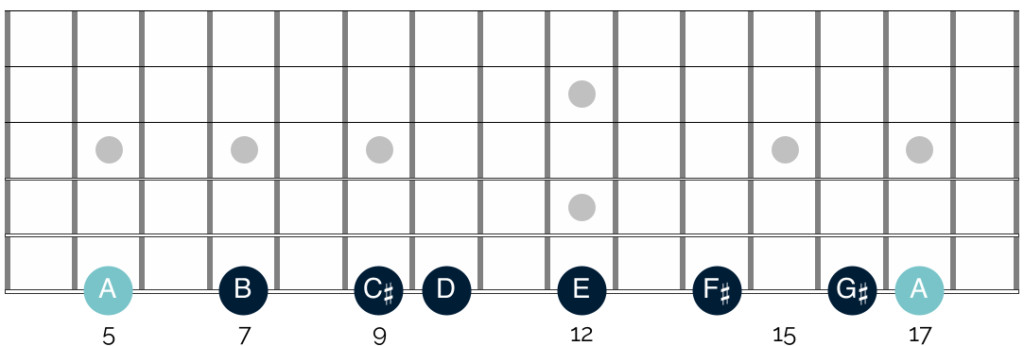 A Major Scale on Guitar Fretboard
A Major Scale on Guitar Fretboard
Visually, you can see the major scale constructed from alternating whole and half steps:
Whole step | Whole step | Half step | Whole step | Whole step | Whole step | Half step
Many guitarists find repeating this pattern helpful for memorizing the scale. It’s a useful method for recalling the note pattern, which has a distinct sound and feel compared to other scales you might know.
As a reminder, here are the 5 shapes of the A major scale across the fretboard:
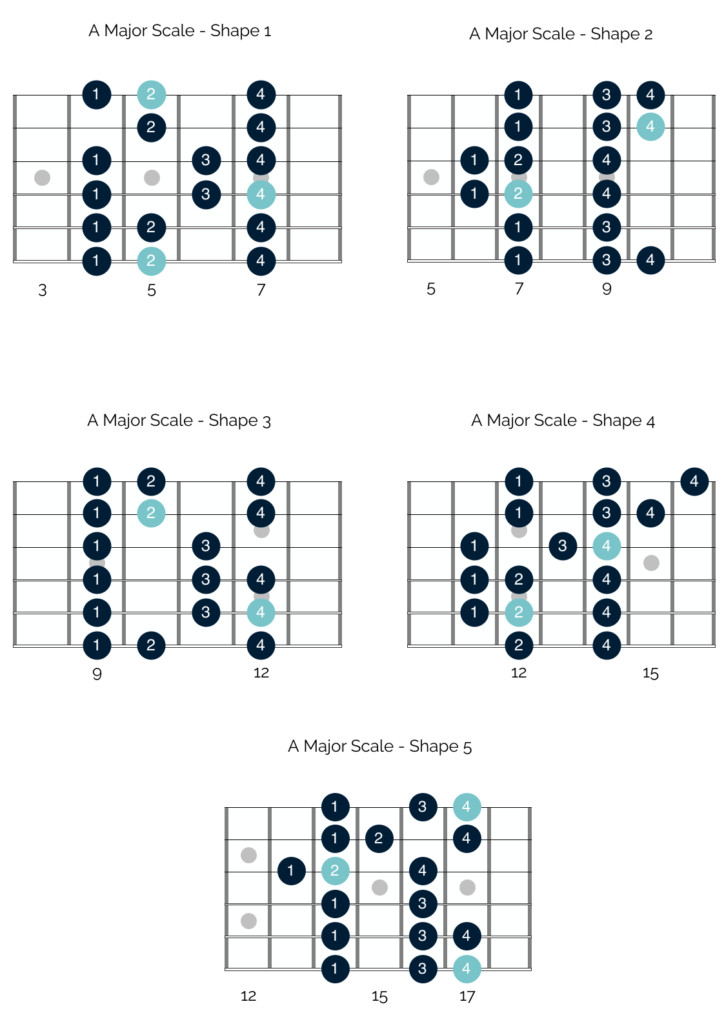 Five Shapes of the A Major Scale for Guitar
Five Shapes of the A Major Scale for Guitar
As detailed here, various fingerings exist for these shapes. However, the fingerings shown are particularly effective for blues and blues rock guitarists. The light blue notes are tonic notes, which are A in this example.
Unlike some other guitar scales, the major scale isn’t immediately intuitive to use in your playing. In blues and blues rock, you’re less likely to use the major scale frequently. Instead, guitar modes become much more relevant.

Demystifying Guitar Modes
Guitar modes are a set of scales derived from the major scale. They utilize all the same notes as their parent major scale. The crucial distinction is that each mode begins on a different note of the major scale.
This shift in starting note significantly alters the intervals between the notes, fundamentally changing the sonic character of each modal scale. This holds true even though they share the same set of notes.
This is the core concept to grasp when learning modes. Let’s illustrate this with a quick example using the A major scale again:
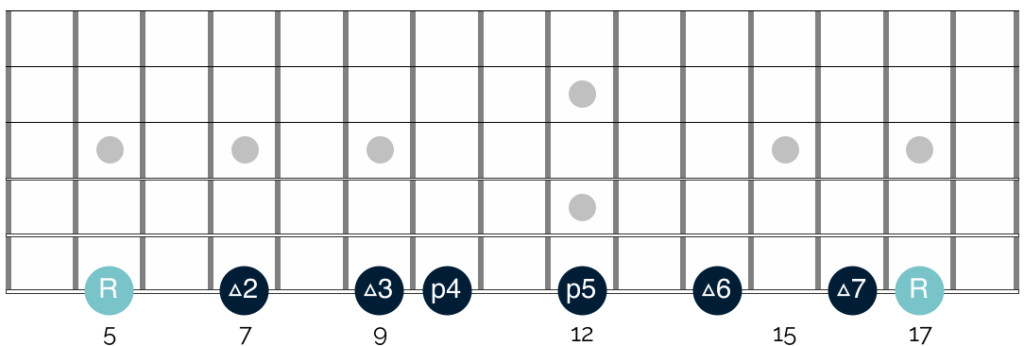 A Major Guitar Scale Diagram
A Major Guitar Scale Diagram
This diagram shows the notes and intervals of the A major scale. Starting on A and playing the major scale results in the intervals shown.
Now, keeping the notes the same, let’s change the starting note to B instead of A. Notice how all the intervals between the notes shift:
 B Dorian Scale on Guitar Fretboard
B Dorian Scale on Guitar Fretboard
The notes in this second diagram are identical to the A major scale diagram. The only difference is that B is now the root note, not A. This seemingly small change has a ripple effect. It alters the intervals, profoundly impacting the scale’s sound and function.
This concept will become clearer as we explore each mode in detail. Hopefully, this example clarifies this key idea, essential for understanding how guitar modes function.
Let’s now look at some broader aspects of modes before diving into specifics.
The Fundamentals of Guitar Modes
There are 7 guitar modes, each built upon one of the 7 notes of the major scale. So, there’s a mode starting on the second note, the third, and so on.
A hurdle in learning modes is their Greek names. The modes and their order are:
| Ionian | Dorian | Phrygian | Lydian | Mixolydian | Aeolian | Locrian |
|---|
Mnemonics can help remember the names and order. Two popular ones are:
- I Don’t Particularly Like Modes A Lot
- I Don’t Particularly Like My Aunt Lucy
Memorizing the order isn’t crucial immediately, but familiarizing yourself with the names early on is beneficial. It eases you into the modal language and reduces initial confusion arising from their unfamiliar names.
Now, let’s focus on modal construction. This will help you understand each mode’s structure, characteristics, and how to play them on guitar.
Modal Construction Explained
As mentioned, each of the 7 modes is built from a note of the major scale. Ionian starts on the first note, Dorian on the second, Phrygian on the third, and so forth.
Starting with the A major scale, the modes are:
| A Ionian | B Dorian | C♯ Phrygian | D Lydian | E Mixolydian | F# Aeolian | G# Locrian |
|---|
Each modal scale is built from a new root note, relating back to that starting note.
Even though we begin with the A major scale and technically use its notes throughout the modes, we don’t end up with A Dorian, A Phrygian, etc. Instead, we get B Dorian, C♯ Phrygian, and so on.
Understanding this is crucial for grasping how modal scales fit together and how to navigate and use them in your guitar playing.
This principle applies to all keys. In C major (notes: C D E F G A B), modal scales will differ from A major. You’ll get D Dorian, E Phrygian, F Lydian, and so on. Starting in E major or G major would yield different results again.
This might sound confusing initially, but don’t worry about mastering everything at once.
The key takeaway for now is that in any major key, the Ionian mode starts on the first note, Dorian on the second, Phrygian on the third, and so on.
The Relationship Between Modes and Chords
The final piece before exploring individual modes is chord construction. As detailed in this article here, harmonizing the major scale into triads results in this chord series:
| Major | Minor | Minor | Major | Major | Minor | Diminished |
|---|
In A major, this gives you:
| A major | B minor | C♯ minor | D major | E major | F# minor | G# diminished |
|---|
Just as modes are based on notes A, B, C♯, etc., the chords follow the same pattern. The ‘I’ chord in B Dorian is B minor. In C♯ Phrygian, it’s C♯ minor, and so on.
The significance of this will become clearer. For now, keep this connection in mind.
Now, let’s delve into each mode individually to understand their construction and sound.
Ionian Mode: The Major Scale Itself
The first mode, Ionian, is straightforward. It’s essentially the same as the major scale.
The two terms are interchangeable, with ‘major scale’ being far more common. Guitarists rarely refer to the Ionian mode.
Ionian is a major mode. It sounds upbeat, bright, and happy, with a triumphant and grand quality. It’s prevalent in classical music and film scores (examples below). Key facts about Ionian:
| Scale Formula | 1 2 3 4 5 6 7 | |
|---|---|---|
| Notes in A Ionian | A B C♯ D E F# G# | |
| Chords | A major, B minor, C♯ minor, D major, E major, F# minor, G# diminished |
Here’s the first shape of A Ionian. Blue notes are tonic (A):
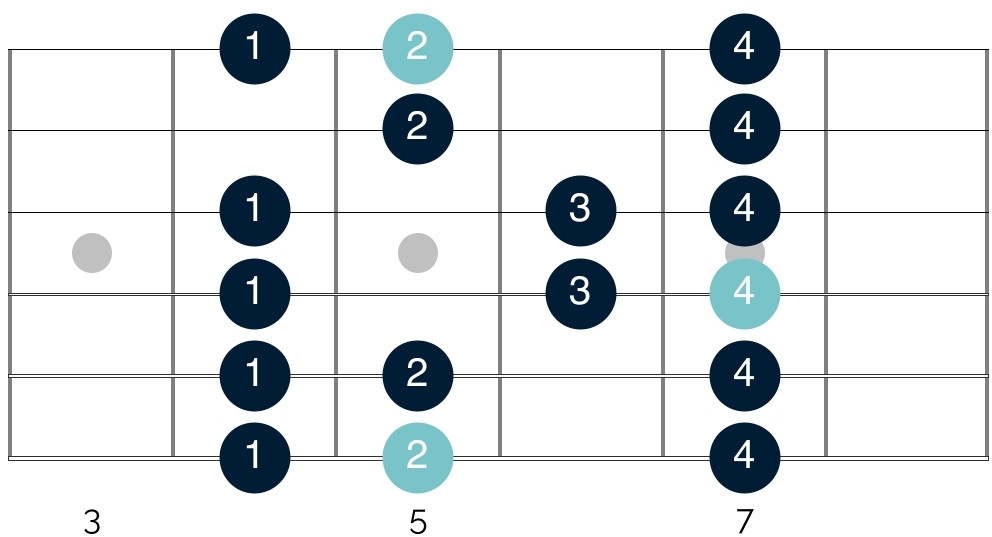 Ionian Mode First Shape on Guitar
Ionian Mode First Shape on Guitar
And here’s how it sounds in A over an A chord:
[Sound Example of Ionian Mode] [Ideally, an audio clip would be embedded here]
Due to its bright sound, Ionian isn’t common in blues or rock. However, some songs use it. Examples include:
- “Here Comes the Sun” – The Beatles
- “Happy” – Pharrell Williams
It’s more common in classical music. For a triumphant Ionian sound, listen to John Williams’ “Raider’s March” or “Superman March”.
Dorian Mode: The Laid-Back Minor Mode
Dorian, the second mode, is a minor mode, sounding more subdued than Ionian. Yet, compared to other minor modes, Dorian isn’t very melancholic or dark.
It has a laid-back, relaxed feel, making it a popular mode. Key facts about Dorian:
| Scale Formula | 1 2 b3 4 5 6 b7 | |
|---|---|---|
| Notes in B Dorian | B C♯ D E F# G# A | |
| Chords | B minor, C♯ minor, D major, E major, F# minor, G# diminished, A major |
First shape of Dorian on guitar. Blue notes are tonic (B):
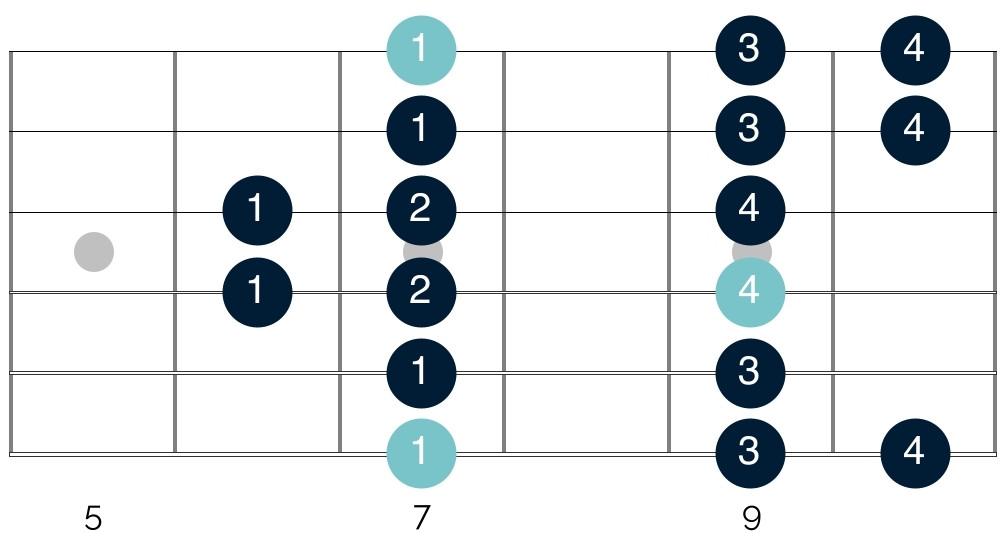 Dorian Mode First Shape on Guitar
Dorian Mode First Shape on Guitar
And its sound in B over B minor:
[Sound Example of Dorian Mode] [Ideally, an audio clip would be embedded here]
Dorian sounds quite different from Ionian, despite sharing the same notes. The relationship between the notes changes because B, not A, is the tonic. This creates a b3 interval (making it minor) and a b7.
These minor intervals give Dorian its minor sound, but the remaining intervals, like Ionian, prevent it from sounding intensely dark.
This balance makes Dorian versatile. It’s frequent in funk, with examples like:
- “So What” – Miles Davis
- “Cissy Strut” – The Meters
Dorian isn’t limited to funk; it’s great in blues and blues rock, adding a unique flavor to improvisations.
Carlos Santana uses Dorian extensively in solos. “Evil Ways” and “Oye Como Va” are Dorian-based. David Gilmour also uses it effectively; “Another Brick In The Wall Pt. II” is Dorian-based.

Phrygian Mode: The Dark and Exotic Minor
Phrygian, like Dorian, is a minor mode, but it’s much heavier and darker. Key facts about Phrygian:
| Scale Formula | 1 b2 b3 4 5 b6 b7 | |
|---|---|---|
| Notes in C♯ Phrygian | C♯ D E F# G# A B | |
| Chords | C♯ minor, D major, E major, F# minor, G# diminished, A major, B minor |
First shape of Phrygian on guitar:
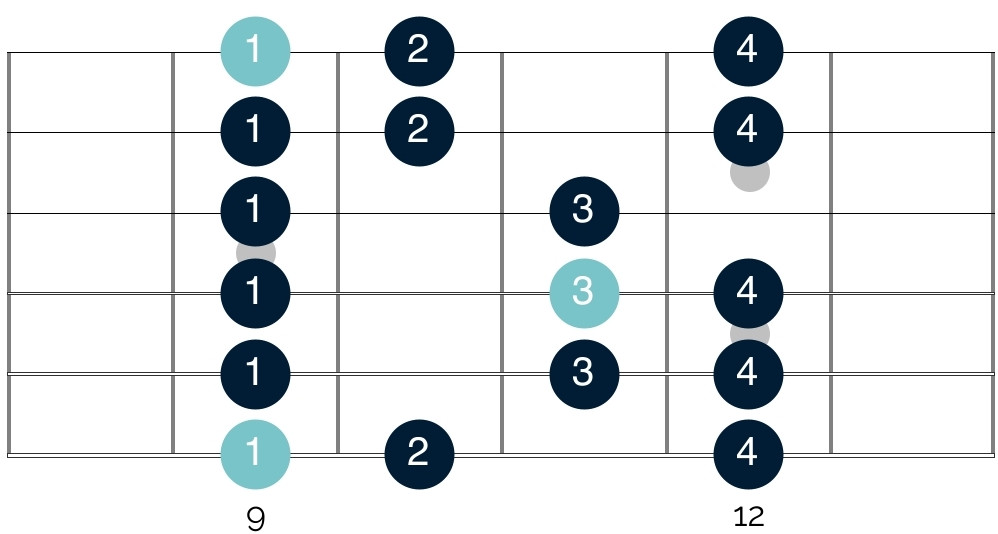 Phrygian Mode First Shape on Guitar
Phrygian Mode First Shape on Guitar
And its sound in C♯ over C♯ minor:
[Sound Example of Phrygian Mode] [Ideally, an audio clip would be embedded here]
Phrygian has a more intense, ‘heavy’ feel than Dorian. It’s rarely used in blues (few blues or blues rock songs use it significantly).
It’s more common in heavy metal. Notable Phrygian songs:
- “Symphony of Destruction” – Megadeth
- “Wherever I May Roam” – Metallica (verses)
The b2 interval in Phrygian gives it an exotic feel. This sound, while not suited for blues, can be effective depending on the music you create.
Lydian Mode: The Dreamy Major Sound
Lydian, like Ionian, is a major mode, with a scale formula almost identical to Ionian. Key facts about Lydian:
| Scale Formula | 1 2 3 #4 5 6 7 | |
|---|---|---|
| Notes in D Lydian | D E F# G# A B C# | |
| Chords | D major, E major, F# minor, G# diminished, A major, B minor, C# minor |
The only difference from Ionian is the #4. Though just one note different, Lydian’s character is distinct.
Like Ionian, Lydian is happy and upbeat, but its triumphant feel is replaced by a mystical, ethereal quality.
First shape of Lydian on guitar:
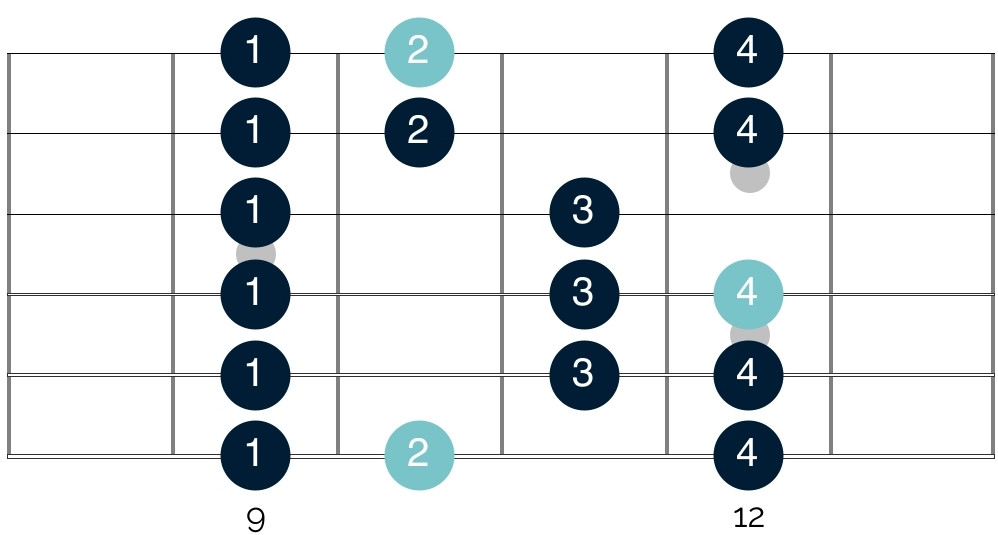 Lydian Mode First Shape on Guitar
Lydian Mode First Shape on Guitar
And its sound in D over D major:
[Sound Example of Lydian Mode] [Ideally, an audio clip would be embedded here]
The #4 interval gives Lydian its unique feel. Musicians use it for an ‘otherworldly’ sound. Lydian song examples:
- “Here Comes My Girl” – Tom Petty and the Heartbreakers (chorus)
- “Jane Says” – Jane’s Addiction
This ethereal sound isn’t ideal for blues or blues rock. Lydian is less common in these genres.
Mixolydian Mode: The Bluesy Major Mode
Mixolydian, also a major mode, is also just one note different from Ionian. Key facts about Mixolydian:
| Scale Formula | 1 2 3 4 5 6 b7 | |
|---|---|---|
| Notes in E Mixolydian | E F# G# A B C# D | |
| Chords | E major, F# minor, G# diminished, A major, B minor, C# minor, D major |
The difference is a b7. This b7 removes some of Ionian’s happiness, making it tenser and bluesier – perfect for blues and rock guitarists.
First shape of Mixolydian on guitar:
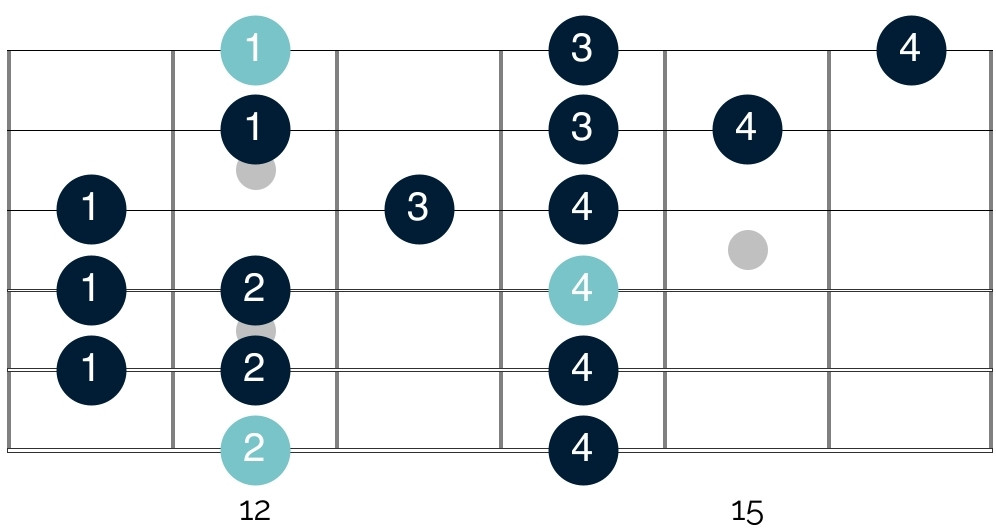 Mixolydian Mode First Shape on Guitar
Mixolydian Mode First Shape on Guitar
And its sound in E over E major:
[Sound Example of Mixolydian Mode] [Ideally, an audio clip would be embedded here]
Mixolydian is a blend of major scale and blues scale. It’s excellent for major blues soloing and adding depth to blues playing. Mixolydian song examples:
- “Sweet Home Alabama” – Lynyrd Skynyrd
- “Rock and Roll” – Led Zeppelin
- Many AC/DC songs
Mixolydian’s sound is perfect for upbeat blues or blues rock. AC/DC uses it so much it defines their sound.
Aeolian Mode: The Natural Minor
Aeolian, also called natural minor or relative minor scale, is a minor mode. It’s between Dorian and Phrygian in sound and feel – more melancholic than Dorian, with more bite, but less intense than Phrygian. Key facts about Aeolian:
| Scale Formula | 1 2 b3 4 5 b6 b7 | |
|---|---|---|
| Notes in F# Aeolian | F# G# A B C# D E | |
| Chords | F# minor, G# diminished, A major, B minor, C# minor, D major, E major |
First shape of Aeolian on guitar:
 Aeolian Mode First Shape on Guitar
Aeolian Mode First Shape on Guitar
And its sound in F# over F# minor:
[Sound Example of Aeolian Mode] [Ideally, an audio clip would be embedded here]
Aeolian is widely used in blues and blues rock, so you’ll encounter it often. It can add depth to minor blues improvisations. Aeolian song examples:
- “Stairway to Heaven” – Led Zeppelin (verses)
- “Losing My Religion” – R.E.M.
- “Hurt” – Johnny Cash (Nine Inch Nails cover)
Mixolydian is great for major blues, while Aeolian is excellent for soloing over minor blues progressions.
Locrian Mode: The Theoretical Mode
Locrian, the final mode, is largely theoretical. Most musicians disregard it for composing and performing due to its tense, unsettled sound.
Like Dorian, Phrygian, and Aeolian, Locrian is minor, but its tonic chord is diminished. Diminished chords are dissonant, making Locrian jarring. Key facts about Locrian:
| Scale Formula | 1 b2 b3 4 b5 b6 b7 | |
|---|---|---|
| Notes in G# Locrian | G# A B C# D E F# | |
| Chords | G# diminished, A major, B minor, C# minor, D major, E major, F# minor |
First shape of Locrian on guitar:
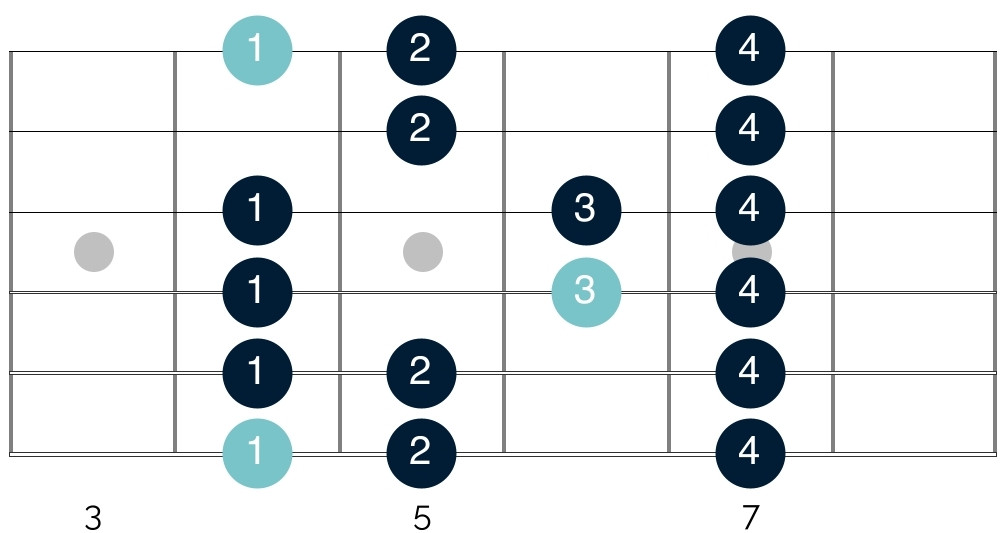 Locrian Mode First Shape on Guitar
Locrian Mode First Shape on Guitar
And its sound in G# over G# diminished:
[Sound Example of Locrian Mode] [Ideally, an audio clip would be embedded here]
Finding purely Locrian songs is difficult. The diminished chord center doesn’t sound resolved. The resolution we seek in music is absent. Few songs truly use it. Examples with Locrian elements:
- “YYZ” – Rush (brief section)
- Some avant-garde jazz
These songs only feature elements of Locrian, not being purely based on it.
Unless you aim for intensely dissonant music, Locrian is rarely encountered. It’s included for completeness, giving you a thorough understanding of all guitar modes.

Modal Scale Shapes – Part 1
Hopefully, you now understand the theory and sound of modes. But how do you play them on guitar?
The great news is you don’t need to learn new scale shapes for modes.
Major scale (Ionian mode) shapes are exactly the same for the other 6 modes. Compare major scale diagrams with individual modal shapes – no new shapes are introduced.
You might have noticed relationships between modal scale shapes. If not, let’s explore this in detail.
The relationship between modal scales:
Dorian (2nd mode) starts with the second shape of the major scale. Dorian uses the same shapes as the major scale, but shifted. Major scale shape 3 becomes Dorian shape 2, major scale shape 4 becomes Dorian shape 3, and so on.
Reaching shape 5, you cycle back to shape 1. Dorian starts with major scale shape 2, then uses shapes 3, 4, 5, and 1.
Similarly, Phrygian (3rd mode) starts with the third major scale shape. Again, same shapes, but shifted. Major scale shape 4 becomes Phrygian shape 2, major scale shape 5 becomes Phrygian shape 3, and so on.
Like Dorian, reaching major scale shape 5 in Phrygian leads to shape 1. Phrygian starts with major scale shape 3, then uses shapes 4, 5, 1, and 2.
Modal Scale Shapes – Part 2
With 5 major scale shapes but 7 modes, this pattern can’t continue through all modes. By the 6th mode, you’d loop back to the first major scale shape.
Therefore, the pattern diverges slightly at two points.
First, Lydian shapes and order are exactly the same as Phrygian. The difference is they start on different tonic notes. Comparing first shapes:
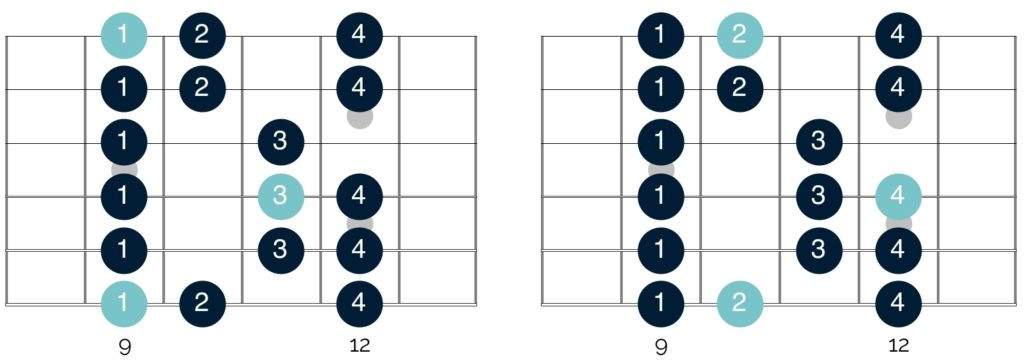 Phrygian vs Lydian Guitar Scale Shapes
Phrygian vs Lydian Guitar Scale Shapes
Left: Phrygian. Right: Lydian. Shapes and positions are identical. Only the root note changes: C♯ for Phrygian, D for Lydian.
The same relationship exists between Ionian and Locrian. Shapes and order are exactly the same. Difference: tonic notes. First shapes:
Caption: Side-by-side comparison of Ionian and Locrian mode shapes, highlighting the same finger patterns with root notes A for Ionian and G# for Locrian.
Left: Ionian. Right: Locrian. Again, shapes and positions are identical. Root note difference: A for Ionian, G# for Locrian.
Modes in Musical Context
Changing the root note only matters in a musical context.
Playing Phrygian and Lydian shapes sequentially will sound identical, as will Ionian and Locrian. They only sound different in a musical context. This is true for all modes, a key point for using modes in your playing.
Each mode’s sound emerges when played in its intended context. For B Dorian, play Dorian shapes over a B minor chord. For C♯ Phrygian, play Phrygian shapes over a C♯ minor chord.
Without this context, a modal scale will sound like the mode connected to the chord you’re playing over. Examples clarify this:
Playing B Dorian’s first shape over a B minor chord creates a Dorian sound:
[Sound Example of Dorian Mode over Minor Chord] [Ideally, an audio clip would be embedded here]
Playing the same shape over an A major chord sounds like A Ionian:
[Sound Example of Ionian Mode over Major Chord] [Ideally, an audio clip would be embedded here]
B Dorian and A Ionian notes are the same, as are C♯ Phrygian and D Lydian, etc. Each shape can produce different sounds. Knowing the chords and musical context is key to creating a specific modal sound.
How to Use Guitar Modes in Your Playing
Now, how do you actually use modes in your guitar playing?
In-depth coverage is beyond this article. It’s a lengthy topic to be explored more in future articles, particularly Dorian, Mixolydian, and Aeolian – the most relevant modes for blues and blues rock.
Here are fundamental points to start using modes in your guitar playing.
Recap of modes and their characteristics:
| Mode | Ionian | Dorian | Phrygian | Lydian | Mixolydian | Aeolian | Locrian |
|---|---|---|---|---|---|---|---|
| Scale Formula | 1 2 3 4 5 6 7 | 1 2 b3 4 5 6 b7 | 1 b2 b3 4 5 b6 b7 | 1 2 3 #4 5 6 7 | 1 2 3 4 5 6 b7 | 1 2 b3 4 5 b6 b7 | 1 b2 b3 4 b5 b6 b7 |
| Notes in A major | A B C♯ D E F# G# | B C♯ D E F# G# A | C♯ D E F# G# A B | D E F# G# A B C♯ | E F# G# A B C♯ D | F# G# A B C♯ D E | G# A B C♯ D E F# |
| Chords | A, Bm, C♯m, D, E, F#m, G♯mb5 | Bm, C♯m, D, E, F#m, G♯mb5, A | C♯m, D, E, F#m, G♯mb5, A, Bm | D, E, F#m, G♯mb5, A, Bm, C♯m | E, F#m, G♯mb5, A, Bm, C♯m, D | F#m, G♯mb5, A, Bm, C♯m, D, E | G♯mb5, A, Bm, C♯m, D, E, F#m |
| Tonality | Major | Minor | Minor | Major | Major | Minor | Minor/Diminished |
Using this table, let’s see how to use modes for soloing and rhythm.
Soloing with Guitar Modes
For modal improvisation, determine the key and tonality (major or minor). Then choose a mode.
In a minor key, you have 3 minor modes: Dorian, Phrygian, and Aeolian.
In a major key, 3 major modes: Ionian, Lydian, and Mixolydian.
Locrian is mostly theoretical and rarely used in playing.
Mode choice depends on the desired feel and the chords you’re soloing over (a complex point beyond this scope).
Ensure your chosen modal scale matches the underlying chord. D Lydian over a D major chord, C♯ Phrygian over a C♯ minor chord, etc.
These ideas extend beyond A major. For D Dorian, move modal shapes to reflect the key change. D Dorian’s first shape:
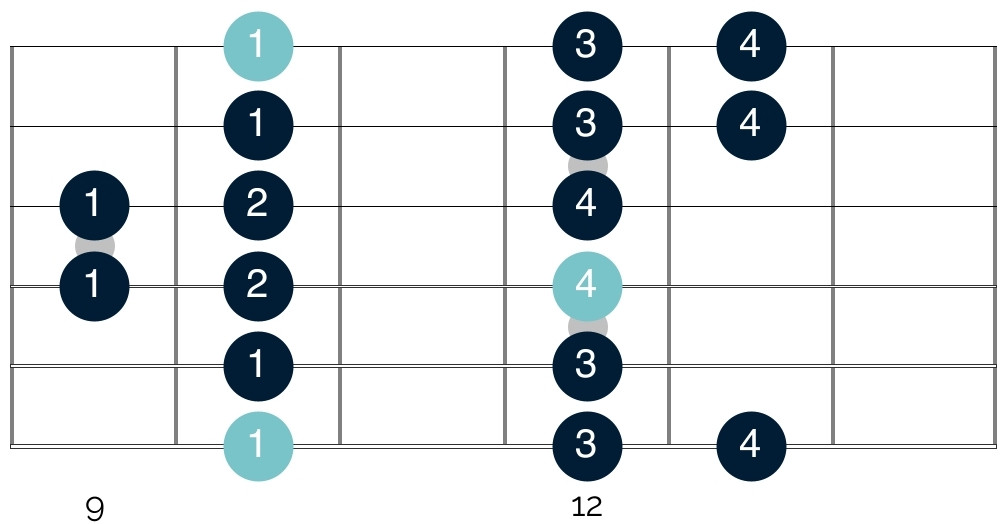 D Dorian Guitar Scale Shape
D Dorian Guitar Scale Shape
D Dorian’s shape is the same as B Dorian. Only the starting note changes. This applies to all modes – move the first shape to a new fretboard position.
Playing Chords with Guitar Modes
Harmonizing the major scale creates 7 chords, used in chord progressions. Musicians use Roman numerals for these chords.
In A major, A major is I, B minor is ii, and so on. Uppercase for major, lowercase for minor. Diminished chords also use lowercase, with a ‘°’ symbol.
Chord progressions change as you cycle through modes. In A major, I, ii, iii are A major, B minor, C♯ minor. In B Dorian, the first chord (i) is B minor, ii is C♯ minor, III is D major.
In A Ionian, I, ii, iii chords are A major, B minor, C♯ minor. In B Dorian, they are B minor, C♯ minor, D major. This shift continues through modes. Comparing chords across modes:
| Mode | Ionian | Dorian | Phrygian | Lydian | Mixolydian | Aeolian | Locrian |
|---|---|---|---|---|---|---|---|
| Notes in A major | A B C♯ D E F# G# | B C♯ D E F# G# A | C♯ D E F# G# A B | D E F# G# A B C♯ | E F# G# A B C♯ D | F# G# A B C♯ D E | G# A B C♯ D E F# |
| Chords | A, Bm, C♯m, D, E, F#m, G♯mb5 | Bm, C♯m, D, E, F#m, G♯mb5, A | C♯m, D, E, F#m, G♯mb5, A, Bm | D, E, F#m, G♯mb5, A, Bm, C♯m | E, F#m, G♯mb5, A, Bm, C♯m, D | F#m, G♯mb5, A, Bm, C♯m, D, E | G♯mb5, A, Bm, C♯m, D, E, F#m |
| Chord Numbers | I, ii, iii, IV, V, vi, vii° | i, ii, III, IV, v, vi°, VII | i, II, III, iv, v°, VI, vii | I, II, iii, iv°, V, vi, vii | I, ii, iii°, IV, v, vi, VII | i, ii°, III, iv, v, VI, VII | i°, II, iii, iv, V, VI, vii |
Don’t worry about memorizing these chords. Understand how chord progressions change as you move through modes.
Putting It All Together
This is a foundation for guitar modes and their application.
If you’re new to this, don’t feel pressured to grasp it all at once. Understanding and using modes is challenging, representing a significant step beyond pentatonic scales, requiring more theory knowledge.
Work through this slowly. Understanding and feeling comfortable with these concepts is better than rushing and missing pieces. Modes require piecing together various music theory elements. Missing one piece can obscure the bigger picture.
Don’t rush. Take time to understand these concepts, as this article is an introduction to guitar modes.
You can delve much deeper into this topic. Future articles will cover practical modal usage in more detail, especially Dorian, Mixolydian, and Aeolian.
Solid understanding of these fundamentals is crucial for confidently using modes in your playing and continuing to improve without knowledge gaps.
Good luck! Let me know your progress and questions in the comments or email me at [email protected]. I’m happy to help! 😁
References & Images
Unsplash, YouTube, Registry Of Guitar Tutors, YouTube, Ultimate Guitar, YouTube, Guitar World, Wikipedia, YouTube, Premier Guitar, Guitar Theory For Dummies, YouTube, Music Stack Exchange, YouTube, YouTube, Guitar Lesson World, The Practical Guide To Modern Music Theory For Guitarists
